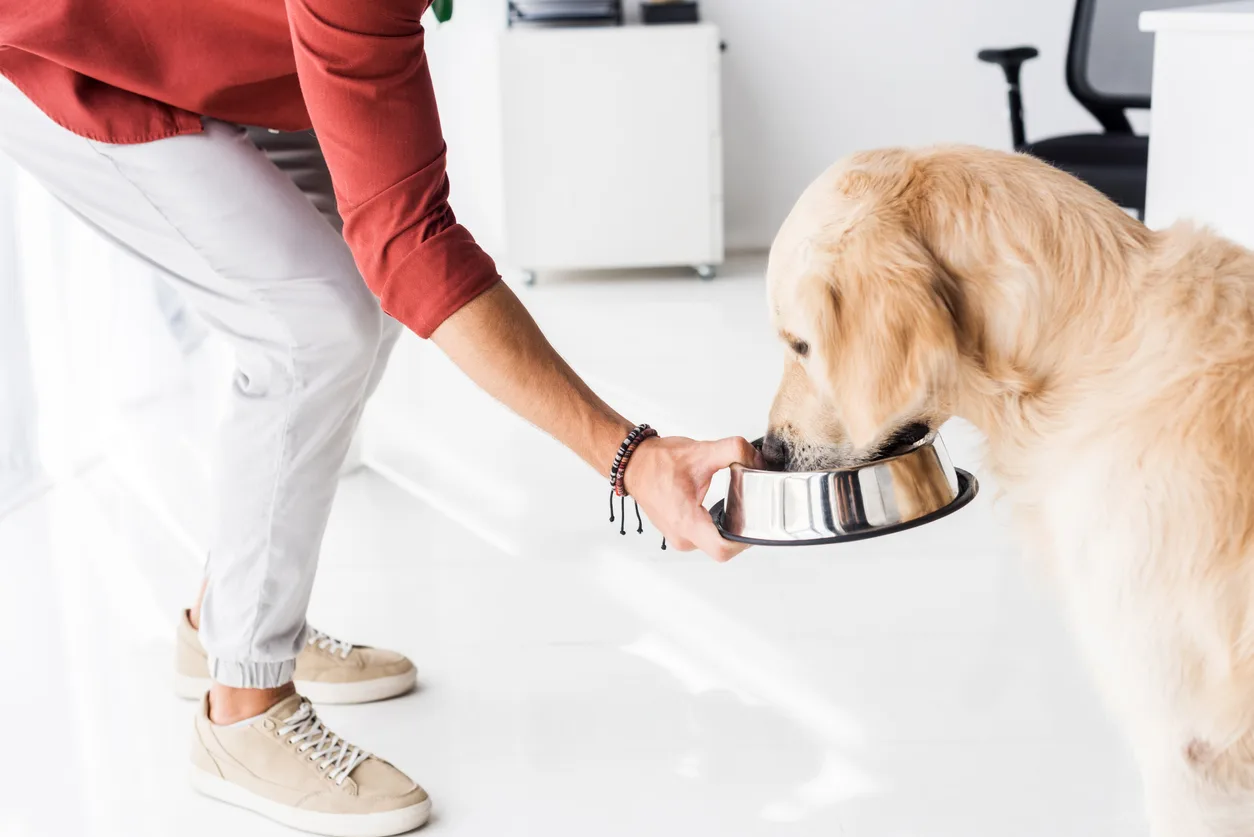We all know how much our dogs love to eat. Traditional dog foods, treats, and even table scraps are the stuff of puppy dreams. Our pups would eat a lot more than necessary if left to their own devices, but eating too much can be just as bad as eating too little. Truthfully, our ravenous little pups are lucky to have us humans to keep them in check. Whether you’re the pet parent of a Golden or just a teeny, tiny Chihuahua, this guide will help you to better understand your dog’s unique nutritional needs.
How Often You Should Feed Growing Puppies
Believe or or not, growing puppies need to be fed around twice as often as adult dogs, mostly due to their rapid rate of growth in the first year. All that growing and playing and learning demands a lot of calories!
Information About Feeding Puppies
Puppies should be kept with their mother as much as possible during the first eight weeks of life. This will allow them to breastfeed as needed. Nursing, just as with humans, helps puppies build up critical antibodies that set the stage for lifelong growth.
Unfortunately, there are sometimes situations where puppies cannot be kept with the mother long-term. This is often the case for strays or puppies dropped off at shelters around the country. These little ones should be given a veterinary-approved milk replacer at a schedule defined by the vet overseeing their care.
When to Wean Your Puppy From Its Mother
You’ll be able to start weaning your puppy anywhere between four and six weeks of age. This isn’t something you should do suddenly or quickly; as with humans, weaning is a process rather than an event.
Start by mixing a high-quality puppy food with a milk replacer to make a thin slurry or gruel. Your puppy should have access to this newer food as well as regular access to the mother (or milk replacer). Over time, you should gradually reduce the amount of milk in the mixture. The goal is to have your puppy slowly gravitate to solid food without experiencing gastrointestinal upset.
Talk to your veterinarian about the amount of food your puppy needs. The exact volume or formula will vary based on the breed and size of the dog. Toy breeds, for example, need to be fed up to six times per day.
Also be mindful that total daily food amounts aren’t designed to be given just once per day. For example, if your dog needs 1 cup of food per day, you must split the food into around four servings of ¼ cup each. Spread these smaller meals throughout the day rather than giving just one 1-cup serving or two 1/2-cup servings. Puppies have a ton of energy and need more consistent fuel.
How Long Do Puppies Eat Puppy Food?
Puppy food contains vitamins and nutrients puppies need to grow. Young dogs have loads of energy, and they need nutrition that can help them strengthen their bones and teeth while giving them enough calories to get through their active days. Puppy food offers all of this, sustaining them in a way that’s more specific to their needs than adult dog food.
How Often Should You Feed a Puppy?
How often you feed your puppy depends on their age and size. Puppies usually eat three times per day, but you should follow your puppy’s lead to determine the correct number of servings per day. Some puppies want more food less frequently throughout the day, so two big meals may be enough for them. Some puppies prefer to eat less at each meal, so four smaller meals may be the right amount.
Consult the chart on your puppy food bag to determine how much to give your pup. The amount of food you provide will vary according to the puppy’s size and weight.
Each puppy’s needs are unique, and consulting a veterinarian is the best way to get an accurate estimate of how much food your puppy needs. Your veterinarian may have special instructions depending on how big your puppy will grow or if there are any concerns about their development. Your vet may also adjust your feeding schedule based on your puppy’s size.
Many veterinarians use a scale that measures puppies from one to five, with one being too skinny and five being obese. Your puppy should sit somewhere in the middle. If they are higher or lower, they may need more or less food.
How Often Should You Feed a Dog?
So, if most puppies eat three times a day, how often should you feed your adult dog? As dogs grow older, they need less food. They stop growing, so their daily caloric needs decrease. If you overfeed your dog, it can lead to problems down the line, such as skeletal issues. Eating less has also been tied to fewer incidences of diseases like hip joint arthritis.
Most veterinarians say feeding your dog twice a day is optimal. They receive enough nutrition and won’t overeat when you feed them twice daily. You can also adjust this based on your dog’s preferences.
How Much to Feed Adult Dogs
Puppy foods are much higher in calories than foods formulated for mature and senior dogs. Maturity varies by breed; it can happen anywhere between 10 and 16 months depending on the dog. In fact, some dogs don’t reach maturity until just after two years of age!
As for when to feed adult formulas, rely on your vet’s advice. Once you’re ready, gradually mix adult food with puppy food, slowly increasing the ratio until your pup is eating the new blend.
During this crucial time in your pup’s development, you should also start decreasing your feeding frequency. Your dog should go from four servings of food per day down to just two or three (depending again on breed and level of activity). Start by gently increasing the first and last meals while taking from the middle two meals; continue to shrink the extras until you can skip them completely. The serving of food doesn’t change, but it will be easier for your dog to adjust to having his meals split.
But what about free-feeding? Well, some dogs do quite well on free feeding plans. Unfortunately, most don’t have enough self-control to only eat a little and leave the rest alone. There are a few breeds who are simply not food-motivated, though, so this type of diet may work with certain lifestyles.
How Much to Feed Pregnant Dogs
Pregnant and nursing dogs need lots of special attention. Nutrition is critical during a dog’s pregnancy, which lasts approximately 63 days. It is especially important during the first two months after giving birth; creating milk demands far more calories than even pregnancy alone. It’s also important to note that dogs with larger litters may need more calories because they have to produce more milk to keep their puppies fed.
One way to provide additional calories is to allow a bit of free feeding in the antenatal period (just after birth and during nursing). Having a filled food dish nearby will allow mama to get up for a snack whenever she has a moment free from her little ones.
Calories alone aren’t enough; your dog also requires other important nutrients, like fat and essential vitamins or minerals. The demand for specific nutrients is just one part of the reason dog food companies create special blends for pregnant and nursing mothers. If you choose one of these formulas, check the ingredients list; high-quality blends should have meat as the first or second ingredient – not fillers.
Many pregnant dogs continue eating their regular food for the first month and then switch to puppy food for the duration of the pregnancy. If you go this route, you should increase meals to four times per day as you move into the second month of pregnancy.
How To Determine a Dog’s Calorie Needs
Dogs (much like people) have specific calorie needs. The average dog needs approximately 30 calories per pound of body weight per day. Smaller or more active dogs sometimes need more, ranging up to 40 calories per pound.
Knowing your dog’s calorie needs is important; it’s the only way to ensure they don’t overeat. And yes, even treats count! If you have a regular routine that involves giving your dog a biscuit or two before you leave for work, you need to calculate those calories into the overall daily nutritional picture. Adjust your dog’s regular meal servings accordingly.
Why is this so important? For one thing, most treats have a lot more calories than you realize. Beggin Strips, for example, have about 40 calories per treat; Pro Plan Brand Medium Dog Biscuits have 32 calories in total. Larger chews and treats can have anywhere from 170 to 700+ calories. That’s more than a Big Mac at McDonalds!
Foods to Avoid Feeding Your Dog
No matter how often you feed your dog, there will always be foods you should avoid at all costs — including table scraps. The occasional cooked vegetable is a fair enough low-calorie treat, as are non-seasoned plain meats like boneless, skinless chicken breast or roasted beef. As for fatty foods, raw meats, and sweets? They’re all a major no-no. Some cause stomach upset, while others can even be toxic.
Here’s a short list of what to avoid:
- Grapes and raisins (kidney failure).
- Chocolate (theobromine can be toxic).
- Dairy products (lactose intolerance).
- Fruits (acidic and upsetting to the stomach).
- Potatoes (too much starch).
- Onions and garlic (can cause anaemia).
- Alcohol (dogs are attracted to the sweet scents).
- Coconut products (unless your vet specifically prescribes coconut oil).
- Macadamia nuts (can be toxic and/or cause stomach upset).
- Salty foods (can raise blood pressure and cause kidney damage).
- Raw yeast doughs (can rise in the dog’s intestines and cause dangerous gas).
It’s important to remember that this is a shortlist; it isn’t exhaustive. If you aren’t ensure about a food, ask your vet or breeder. As a general rule of thumb, if it’s processed or heavily salted/sugared, it’s probably not a great choice.
As a loyal and loving human, it’s your mission to make sure your dog gets high-quality nutrition throughout the day. Never be afraid to consult your vet if eating behavior changes, or if you think you’re over or under-feeding your dog. They’ll work with you to figure out what foods are most appropriate for your dog’s breed and any specific health conditions.

